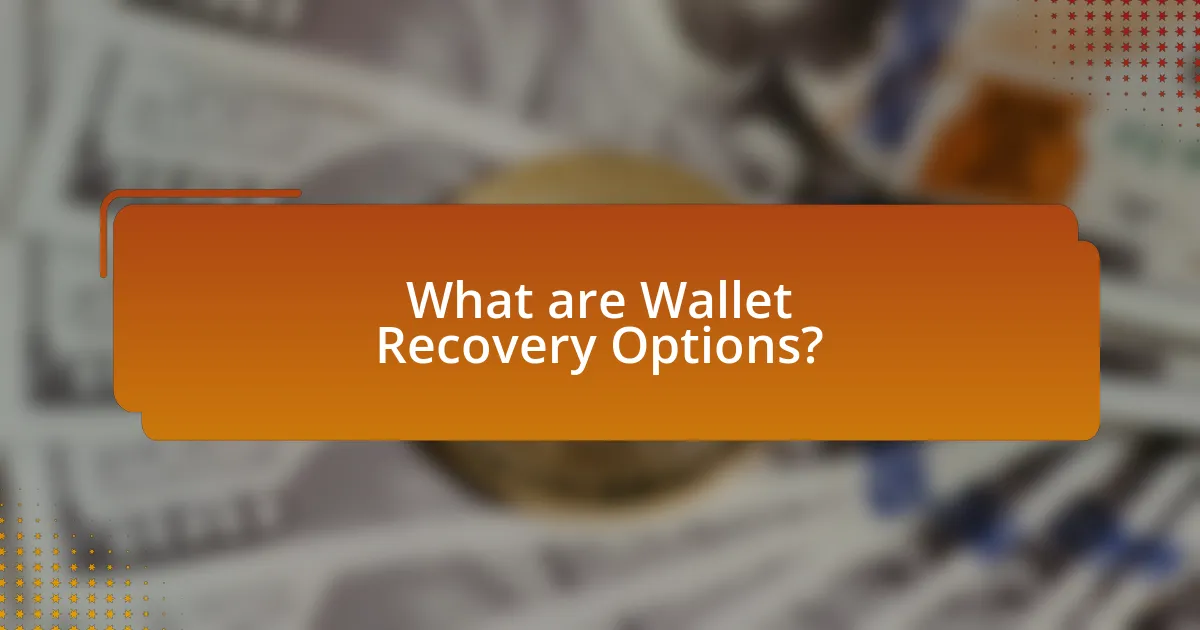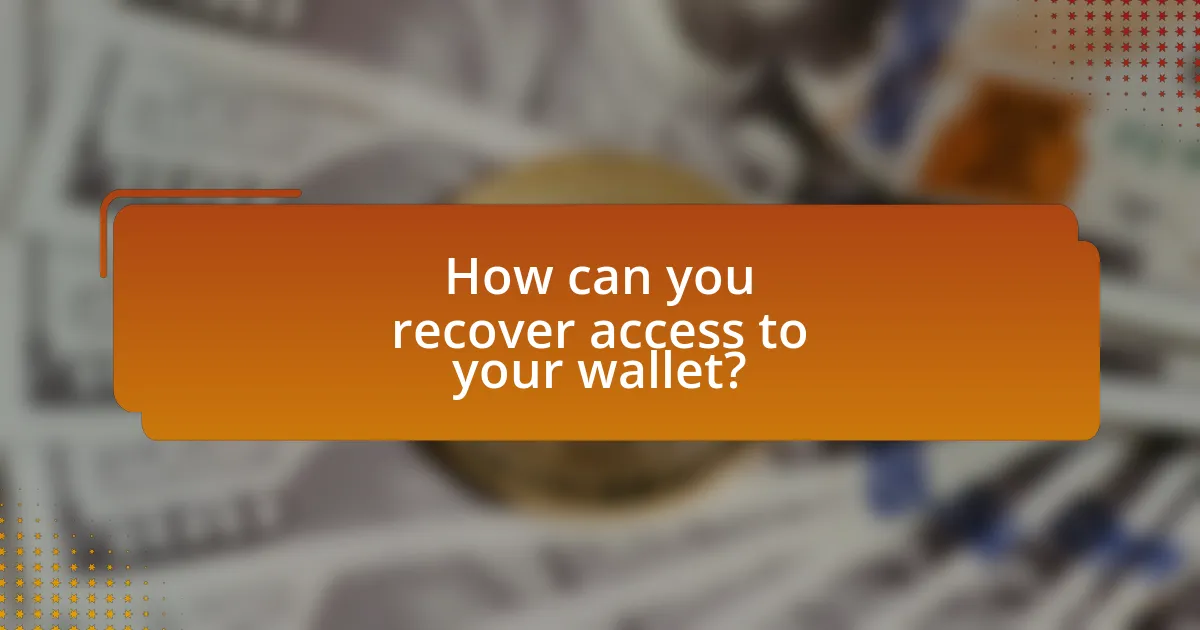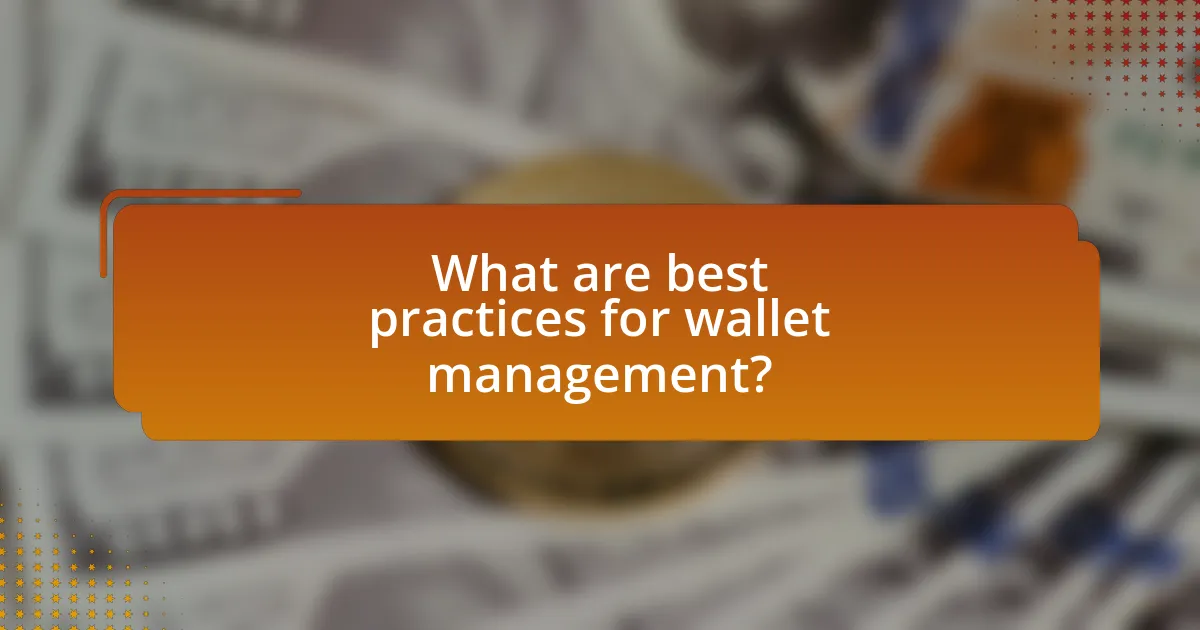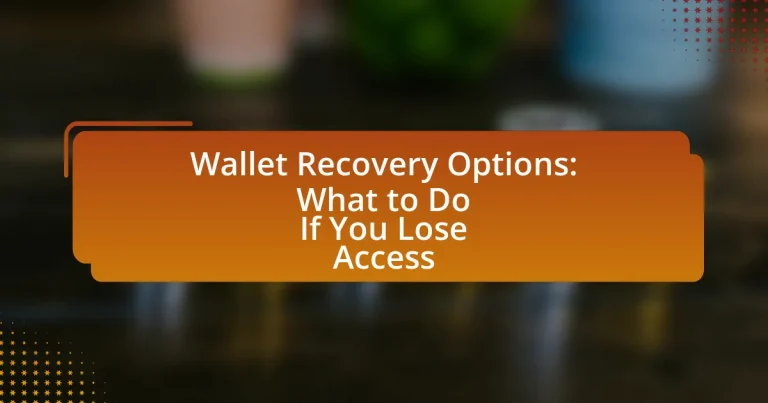Wallet recovery options are essential methods that enable users to regain access to their digital wallets after losing credentials or access. This article outlines various recovery methods, including recovery phrases, backup keys, and customer support services, emphasizing their importance in preventing permanent loss of digital assets. It discusses the risks associated with losing wallet access, the differences between hot and cold wallets, and the specific recovery options available for each type. Additionally, the article provides practical steps for recovering access, tools and resources for assistance, and best practices for wallet management to enhance security and prevent future access issues.

What are Wallet Recovery Options?
Wallet recovery options are methods that allow users to regain access to their digital wallets after losing their credentials or access. These options typically include recovery phrases, backup keys, and customer support services provided by wallet providers. For instance, many cryptocurrency wallets offer a 12 to 24-word recovery phrase that users can write down and store securely; this phrase can restore access to the wallet if the user forgets their password or loses their device. Additionally, some wallets provide backup keys that can be used to recover funds, while others may have customer support teams that assist users in the recovery process.
Why is wallet recovery important?
Wallet recovery is important because it allows users to regain access to their digital assets after losing their wallet credentials. Without recovery options, users risk permanent loss of their cryptocurrencies or tokens, as many wallets do not have a centralized recovery system. For instance, a study by Chainalysis in 2021 revealed that approximately 20% of Bitcoin is considered lost due to inaccessible wallets, highlighting the critical need for effective recovery methods.
What risks are associated with losing access to a wallet?
Losing access to a wallet poses significant risks, primarily the permanent loss of funds stored within that wallet. When access is lost, users cannot retrieve their cryptocurrencies or digital assets, which can lead to financial loss. According to a study by Chainalysis, approximately 20% of all Bitcoin in circulation is considered lost due to inaccessible wallets. Additionally, the inability to access a wallet can result in missed opportunities for trading or utilizing assets, further compounding financial risks.
How can losing access impact your digital assets?
Losing access to your digital assets can result in permanent loss of ownership and inability to retrieve funds or data. Digital assets, such as cryptocurrencies or online accounts, are often secured by private keys or passwords; without access to these credentials, users cannot recover their assets. For instance, a study by Chainalysis in 2021 estimated that around 20% of all Bitcoin is lost due to lost access, equating to billions of dollars in value. This highlights the critical importance of secure backup and recovery options for maintaining access to digital assets.
What types of wallets require recovery options?
Hot wallets and hardware wallets require recovery options. Hot wallets, which are connected to the internet, can be vulnerable to hacks and loss of access, necessitating recovery phrases or backup keys. Hardware wallets, while more secure, also require recovery options to restore access in case the device is lost or damaged, typically through seed phrases or recovery keys. These recovery methods are essential for safeguarding digital assets in both wallet types.
What are the differences between hot wallets and cold wallets?
Hot wallets are online wallets that are connected to the internet, allowing for quick and easy access to cryptocurrencies, while cold wallets are offline storage solutions that provide enhanced security by keeping private keys disconnected from the internet. The primary difference lies in their connectivity; hot wallets facilitate immediate transactions but are more vulnerable to hacking, whereas cold wallets, such as hardware or paper wallets, offer greater protection against cyber threats but require more effort to access funds. According to a report by the Blockchain Research Institute, the risk of theft is significantly higher with hot wallets, making cold wallets a preferred choice for long-term storage of digital assets.
How do recovery options vary between different wallet types?
Recovery options vary significantly between different wallet types, primarily categorized as hardware wallets, software wallets, and paper wallets. Hardware wallets typically offer recovery through a seed phrase or recovery phrase, which is a series of words generated during the wallet setup that allows users to restore access to their funds. Software wallets, including mobile and desktop versions, often provide similar recovery options through seed phrases but may also include additional features like email recovery or password recovery mechanisms. In contrast, paper wallets, which are physical printouts of private keys, lack built-in recovery options; if the paper is lost or damaged, access to the funds is permanently lost. This distinction highlights the importance of understanding the specific recovery mechanisms associated with each wallet type to ensure secure access to cryptocurrency holdings.
What common recovery methods are available?
Common recovery methods for lost wallet access include seed phrase recovery, password recovery, and customer support assistance. Seed phrase recovery involves using the original recovery phrase provided during wallet setup to restore access. Password recovery typically requires answering security questions or using email verification to reset the password. Customer support assistance can provide guidance and solutions based on the specific wallet service being used. These methods are widely recognized in the cryptocurrency community for regaining access to wallets.
How does using a recovery phrase work?
Using a recovery phrase works by providing a series of words that can restore access to a digital wallet or account. When a user creates a wallet, a unique recovery phrase, typically consisting of 12 to 24 words, is generated and must be securely stored. If the user loses access to their wallet, they can input this recovery phrase into the wallet application to regain access to their funds and transaction history. This method is based on cryptographic principles, ensuring that only the holder of the recovery phrase can access the associated wallet, thus providing a secure way to recover lost access.
What role do backup files play in wallet recovery?
Backup files are essential for wallet recovery as they store critical information needed to restore access to a digital wallet. These files typically contain private keys, recovery phrases, or other authentication data that enable users to regain control over their funds after losing access due to device failure, loss, or theft. The importance of backup files is underscored by the fact that without them, users may permanently lose their assets, as many wallets do not offer alternative recovery methods.

How can you recover access to your wallet?
To recover access to your wallet, you should utilize the recovery phrase or seed phrase that was provided when you created the wallet. This phrase typically consists of 12 to 24 words and is essential for restoring access to your wallet on a compatible platform. If you have lost your recovery phrase, recovery options may be limited, as many wallets do not offer alternative methods for access recovery. Therefore, safeguarding your recovery phrase is crucial, as it is the primary means of regaining access to your wallet.
What steps should you take if you lose access?
If you lose access to your wallet, the first step is to attempt recovery using any backup phrases or keys you have stored. Wallets often provide a recovery phrase during setup, which can restore access if you have it saved securely. If you do not have a recovery phrase, check for any associated email accounts for recovery options or contact customer support for assistance. Many wallet providers have specific protocols for lost access, which may include identity verification. Following these steps can help regain access to your wallet and its contents.
How do you locate your recovery phrase or seed?
To locate your recovery phrase or seed, check the original documentation or setup instructions provided when you created your wallet. This phrase is typically displayed during the wallet setup process and should have been written down or securely stored by the user. Many wallets also allow users to access their recovery phrase through the settings or security section of the application, where it may be labeled as “Backup” or “Recovery.” It is crucial to keep this phrase confidential and stored in a safe place, as it is essential for recovering access to your wallet.
What should you do if you can’t find your recovery phrase?
If you can’t find your recovery phrase, you should attempt to access your wallet using any alternative recovery options provided by the wallet service. Many wallet services offer features such as password recovery, biometric authentication, or customer support assistance to help regain access. For example, some wallets allow users to recover accounts through linked email addresses or phone numbers. If these options are unavailable, it may be impossible to recover the wallet, as the recovery phrase is often the only way to restore access to the funds.
What tools and resources can assist in recovery?
Tools and resources that can assist in recovery include recovery phrases, hardware wallets, and recovery services. Recovery phrases, often consisting of 12 to 24 words, allow users to restore access to their wallets if they lose their device. Hardware wallets, such as Ledger and Trezor, provide secure storage and backup options for cryptocurrencies, minimizing the risk of loss. Additionally, professional recovery services can help users regain access to their wallets through specialized techniques, although these services may come with fees. These tools and resources are essential for ensuring that users can recover their wallets effectively and securely.
How can wallet support services help you?
Wallet support services can help you by providing assistance in recovering access to your digital wallet. These services typically offer guidance on resetting passwords, recovering lost private keys, and restoring wallet functionality through secure methods. For instance, many wallet support services have established protocols that ensure user identity verification, which is crucial for preventing unauthorized access. Additionally, they may provide resources such as FAQs, live chat support, or step-by-step recovery guides, enhancing user confidence and security during the recovery process.
What online resources are available for wallet recovery?
Online resources available for wallet recovery include official wallet provider websites, recovery guides, and community forums. Official websites often provide step-by-step recovery processes tailored to their specific wallets, ensuring users follow the correct procedures. Recovery guides, such as those found on platforms like YouTube or dedicated cryptocurrency blogs, offer visual and written instructions that can assist users in navigating the recovery process. Community forums, such as Reddit or specialized cryptocurrency discussion boards, allow users to share experiences and solutions, providing peer support and additional insights into wallet recovery methods.
What precautions should you take during recovery?
During recovery, it is essential to secure your recovery phrases and private keys by storing them in a safe, offline location. This precaution prevents unauthorized access and potential theft of your digital assets. Additionally, ensure that you use reputable recovery tools and services, as using unverified options can lead to scams or loss of funds. Regularly updating your security measures, such as enabling two-factor authentication on your accounts, further enhances your protection during the recovery process.
How can you avoid scams while recovering your wallet?
To avoid scams while recovering your wallet, use only official recovery channels and verify the legitimacy of any service before providing personal information. Scammers often impersonate legitimate services, so always check for secure website connections (HTTPS) and look for reviews or testimonials from credible sources. According to the Federal Trade Commission, consumers reported losing over $1.9 billion to fraud in 2020, highlighting the importance of vigilance during recovery processes.
What security measures should you implement post-recovery?
Post-recovery, implement multi-factor authentication (MFA) to enhance security. MFA adds an extra layer of protection by requiring not only a password but also a second form of verification, such as a text message or authentication app code. According to a study by the Cybersecurity & Infrastructure Security Agency, MFA can block up to 99.9% of automated attacks, significantly reducing the risk of unauthorized access to your wallet. Additionally, regularly update your passwords and ensure they are strong and unique to further safeguard your assets.

What are best practices for wallet management?
Best practices for wallet management include using strong, unique passwords, enabling two-factor authentication, regularly backing up wallet data, and keeping private keys secure. Strong passwords reduce the risk of unauthorized access, while two-factor authentication adds an extra layer of security. Regular backups ensure that wallet data can be restored in case of loss or corruption. Keeping private keys secure, such as storing them offline or using hardware wallets, protects against theft and hacking attempts. These practices are essential for maintaining the integrity and security of digital wallets.
How can you prevent losing access to your wallet in the future?
To prevent losing access to your wallet in the future, regularly back up your wallet’s recovery phrase and private keys in a secure location. This practice ensures that you can restore access even if your device is lost or damaged. According to a study by the Blockchain Research Institute, 20% of cryptocurrency users have lost access to their wallets due to misplaced keys or forgotten passwords, highlighting the importance of secure backups. Additionally, enabling two-factor authentication (2FA) adds an extra layer of security, making unauthorized access more difficult.
What strategies can enhance wallet security?
To enhance wallet security, users should implement multi-factor authentication (MFA), utilize strong and unique passwords, and regularly update software. Multi-factor authentication adds an extra layer of protection by requiring additional verification beyond just a password, significantly reducing the risk of unauthorized access. Strong and unique passwords prevent easy guessing or brute-force attacks, while regular software updates ensure that any security vulnerabilities are patched promptly. According to a study by the Cybersecurity & Infrastructure Security Agency, using MFA can block 99.9% of automated attacks, highlighting its effectiveness in enhancing security.
How often should you back up your wallet information?
You should back up your wallet information at least once a month. Regular backups ensure that you have the most current data in case of device failure or loss. Additionally, backing up immediately after any significant transaction or change in wallet settings is advisable to maintain up-to-date records. This practice is supported by security experts who recommend frequent backups to mitigate the risk of data loss and enhance wallet recovery options.
What are common troubleshooting tips for wallet recovery?
Common troubleshooting tips for wallet recovery include verifying the recovery phrase, ensuring the correct wallet software is used, checking for software updates, and confirming that the wallet is compatible with the blockchain. Users should also look for any typos in the recovery phrase, as even a single incorrect word can prevent access. Additionally, consulting the wallet provider’s support documentation can provide specific recovery steps tailored to the wallet in use. These methods are effective because they address the most frequent issues encountered during wallet recovery, such as incorrect phrases or outdated software.
What should you do if recovery methods fail?
If recovery methods fail, you should seek professional assistance from a cryptocurrency recovery service. These services specialize in retrieving lost access to wallets and can employ advanced techniques to recover funds. According to a report by Chainalysis, approximately 20% of all Bitcoin is considered lost, highlighting the importance of professional recovery options when personal methods do not succeed.
How can you seek professional help for wallet recovery?
To seek professional help for wallet recovery, contact a reputable cryptocurrency recovery service or a cybersecurity expert specializing in digital asset recovery. These professionals typically have the tools and expertise necessary to assist in recovering lost access to wallets, whether due to forgotten passwords, lost private keys, or compromised accounts. It is essential to verify the credentials and reviews of the service provider to ensure their legitimacy and effectiveness in handling such sensitive matters.


